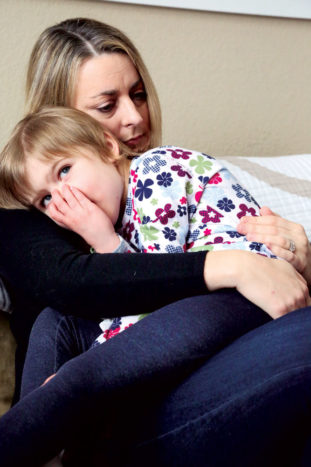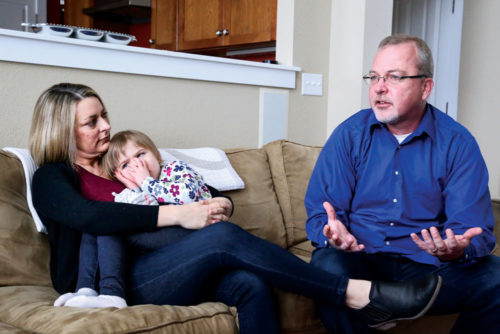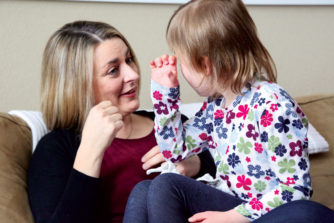
Harper’s mother Scotty Sims says, “Everything’s a battle. You have to fight to get service. You have to fight to get equipment. Everything is a hundred times harder to get and a hundred times more expensive.”
Scotty Sims knew there was something different about her second pregnancy. She told her OB/GYN her baby was “getting in these weird positions and locked, and I was in a lot of pain and discomfort.” Sims kept saying that she thought it was seizures, but with no family history, multiple health care providers reassured her it was probably nothing to worry about.
But soon after Harper’s birth in May, 2011, it became evident that Sims had been right. “We noticed within the first 24 hours concerning behavior,” said Sims. “She ended up having the most common type of seizures…the tonic-clonic…a grand mal. She ended up having one in front of the neonatologist and they immediately were like, oh my gosh, you’re right.”
Born at Rose Hospital, Harper was life-flighted to Children’s Hospital Colorado within a few days of her birth when the seizures didn’t resolve. “They didn’t know what she had. She had every test imaginable. She had MRIs, she had spinal taps,” said Sims. “I just can’t even tell you what it’s like to have someone take your day-old child and tell you they’re going to do spinal taps.”
After four weeks in the Neonatal Intensive Care Unit, the family was discharged home with no diagnosis, a handful of medications and little Harper still experiencing seizures. At five weeks, fortunately, the seizures stopped—due perhaps to a trial medication or just good luck—but the struggle for the Sims-Johnson family had only just begun.
Diagnosis
The underlying reason for Harper’s seizures was unclear until her father, Jim Johnson, came across a paper that described a rare genetic disorder, KCNQ2, and emailed the authors.

Jim Johnson and Scotty Sims have become experts in understanding KCNQ2, a rare genetic disorder that affects daughter, Harper. They founded the KCNQ2 Alliance to raise awareness and improve research for new drug development.
“Essentially, Jim diagnosed her,” said Sims. “We knew she had a mutation in the gene, and then Jim found this research paper that had come out.” Discovered in 2012, according to Sims, KNCQ2 is the leading genetic cause of epilepsy in the first week of life and may affect as many as 1/16,000 live births, though it is still underdiagnosed.
But, “Seizures are only a part of [KCNQ2]. They’re the outward sign…of what’s gone wrong as far as the function of the brain,” said Jim Johnson. “Obviously, most kids have profound, lifelong cognitive disabilities, vision issues, sleep, [gastrointestinal] GI issues. It’s kind of a global package of badness, unfortunately.”
Symptoms
Harper’s symptoms run the gamut, including cognitive disabilities, sleep issues and GI problems. Sims says Harper is considered to be on “the mild end of the severe” spectrum for KCNQ2 and has autistic features. “She’s cognitively 12–14 months, depending on the skill.”
Harper is nonverbal, although she can use sign language to communicate. “It’s kind of like she has this reservoir and she can only hold so many signs. When we give her new signs, other ones kind of fall out,” says Sims. “You want to be careful what you put in because you don’t know what you’re going to lose.” Harper currently attends school in Park Hill at a multi-intensive special needs center.
But the biggest issue for Harper has been her GI symptoms, which reached a low point last September. “She was raging and screaming in pain nonstop,” recounted Sims. “She was self-harming, slapping her face, scratching her face and cutting herself up, and biting herself because she was in pain.” Gelatin suppositories weren’t enough to address the discomfort, which Sims explained was from gas that Harper was unable to expel.
Treatment
The family turned to Children’s Hospital Colorado again. Although they had almost given up on finding help there after multiple, fruitless years of trying, they discovered that Children’s had a program, called Neurogastroenterology, begun in 2013 and headed by Dr. Jaime Belkind-Gerson, who joined in 2016.
The Neurogastroenterology program is the only one of its kind in the region, said Belkind-Gerson, who explained that the gut is like a “second brain.” The GI tract contains half a billion neurons, and “when it works, it’s great.” But in cases like Harper’s, when the neurons are damaged from birth, “the result is they don’t feel OK or move OK” and it can be uncomfortable even to eat, he added.

Harper Johnson, age 6, is nonverbal but has a reservoir of sign language that she uses with parents and caregivers. She has about 50 signs in her vocabulary, but when new ones are introduced, she loses old ones, said her mother, Scotty Sims.
Belkind-Gerson established an immediate rapport with the family, listening and taking seriously their perspective on Harper’s condition. “He said, ‘You know, I hear what you’re saying.’” Said Sims. “That was the greatest thing ever because we had not had that [in the past].”
After addressing Harper’s special pain issues with medication, Belkind-Gerson recommended what seemed an unusual therapy: anal Botox. Botox is sometimes used in special needs kids to relieve muscle tightness or to control drooling through the salivary glands, but this was a new approach for Sims and Johnson.
The results were almost instantaneous for Harper. “It was life-changing,” says Sims. The very afternoon after the surgery, Harper was smiling and laughing for the first time in ages. Harper’s pain had so consumed her that she had been unable to participate in other therapies she needed, but after treatment “she’s in the moment and participating in therapies and not lying on the floor screaming in pain,” said Sims.
The Future
Sims and Johnson are happy that Harper’s GI pain has been addressed, and the relief has allowed them to focus on other aspects of her care, including physical therapy, sleep and motor control. But the family is also intent on advocating for families and raising awareness about the disease, hoping to promote increased research and drug development. To that end, they created a foundation, the KCNQ2 Alliance.
“[KCNQ2] is an attractive target scientifically. Even though it’s fairly newly discovered, they’ve made a lot of progress in understanding it, with a lot of help from foundations like ours, [which is] putting researchers together with pharmaceutical companies,” said Johnson.
The annual summit put on by the KCNQ2 Alliance will take place in Anaheim, California this year, and Sims and Johnson expect over 150 researchers, families, and pharmaceutical company representatives to join in a spirit of collaboration.
They also help bring families together through a Facebook page that Sims administers. She is passionate about the role that parents can play as advocates for their children and urges medical professionals to pay attention. “Listen to the parents. No matter how crazy they might sound, they’re crazy for a reason,” said Sims. “They’re irritated. They’re irritated and angry and persistent for a reason—their child is suffering.”



Love the this article!!!! KCNQ2 momma